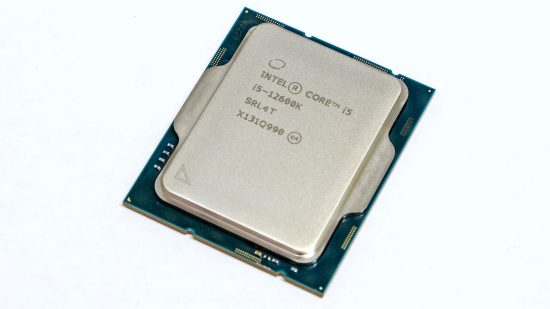Our Verdict
70%Now showing its age compared to the latest CPUs, which offer better value or faster performance for similar cash.
The Core i5-12600K turned out to be one of the best CPUs Intel has made in recent years, with a hefty core-count increase over its predecessor and every aspect you need from a CPU retailing for around £300 inc VAT. That included great gaming and content creation performance, making this Alder Lake CPU a great buy.
However, the Raptor Lake Core i5-13600K is the new kid on the block. It offers even more performance for just £40 more, and the old Core i5 hasn’t really come down in price. In fact, it costs a little more money than when we last looked at it.
In terms of spec, you get a total of ten cores and 16 threads, with a six and four-core split between P-Cores and E. The former can hit a lofty 4.9GHz in peak boost, falling back to around 4.5GHz across all cores in multi-threaded workloads. However, the core count and cache amounts are suspiciously similar to those of the new Core i5-13400F, which costs £80 less, although it does have slightly lower clock speeds.
The 12600K has 20MB of L3 cache and 9.5MB of L2 cache, and the Core i5-13600K beats it here, not only by having more L3 cache and higher frequencies, but also by coming equipped with four extra E-Cores. We’ve included this older CPU in this month’s Labs test for the simple reason that it bridges the price gap between the Core i5-13400F and Core i5-13600K, and it’s also a possible cheaper alternative to a Ryzen 5 7600X or Ryzen 7 7700 system, with those CPUs retailing for £249 and £330 respectively.
When it comes to performance, the Core i5-12600K (just) proved to be faster than the Core i5-13400F in every RealBench test, resulting in a system score of 288,414 compared to 271,519, but the extra grunt you get from stumping up another £40 for the Core i5-13600K is well worth it, given the latter’s system score was 372,186. The Ryzen 7 7600X managed 350,361, also representing a significant step up.
It was quicker than the Core i5-13400F in Cinebench too, with a multi-threaded test score of 17,383 comparing to 15,378, but again the Core i5-13600K was significantly more powerful with a score of 24,268. The Ryzen 5 7600X was noticeably slower here, while the Ryzen 7 7700 was only 1,000 points ahead.
Games were a different story, though, where the Core i5-13400F offered similar performance, albeit slightly lower average frame rates, while the Ryzen 5 7600X was quicker. There’s some overclocking room here, though, and unlike the Core i5-13400F, the 2600K has an unlocked multiplier. Using a vcore of 1.36V, we hit 5GHz across all P-cores, which saw it leapfrog the Ryzen 5 7600X’s system score and outstrip the Ryzen 7 7700, even when it was overclocked. Sadly, the latter was still faster in games though.
Conclusion
There isn’t really a situation you’d consider the Core i5-12600K given its current price, as the Core i5-13600K is significantly faster across the board and only costs £40 more. The Core i5-13400F, meanwhile, also offers big savings with little loss in performance while the cheaper Ryzen 5 7600X is faster in games. It’s still a fast, overclockable CPU, but it’s one that could do with its own price cut.
Price
£290
Scores
Performance: 36/50 | Features: 14/15 | Value: 27/35
Pros
- Overclockable
- Good out-of-the-box performance
- A match for Ryzen 7 7700 once overclocked
Cons
- Too expensive
- Core i5-13400F is nearly as fast
- Core i5-13600K is only £40 more and miles faster
Intel Core i5-13400F Specs
- Base frequency: P-Core 3.7GHz, E-Core 2.8GHz
- Max boost frequency: P-Core 4.9GHz, E-Core 3.6GHz
- Core: Alder Lake
- Manufacturing process: 10nm
- Number of cores: 6 P-Cores, 4 E-Cores, (16 threads)
- Hyper-Threading: Yes
- Cache: 20MB L3, 9.5MB L2
- Memory controller: Dual-channel DDR4 and DDR5
- Packaging: ALGA1700
- Thermal design power (TDP): 150W
- Features: Turbo Boost 2, FMA3, F16C, SHA, BMI / BMI1 + BMI2, AVX-512, AVX2, AVX, AES, SSE4a, SSE4, SSSE3, SSE3, SSE2, SSE, MMX
